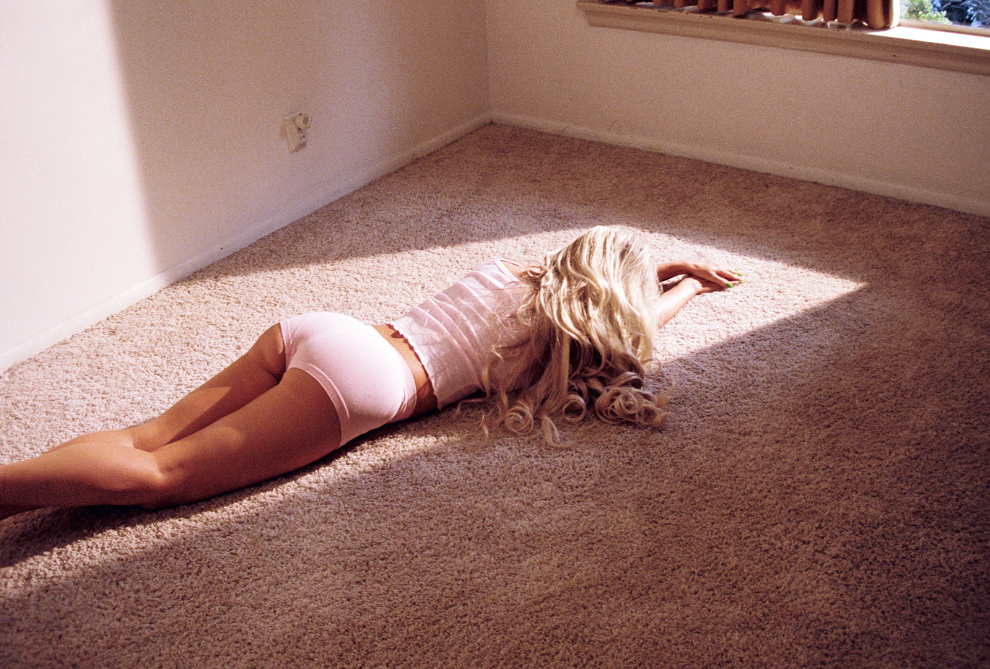Pretty When You Cry
Petra Collins constructs a visual dialect of femininity and surveillance, styling vulnerability through hyperfeminine codes that both seduce and unsettle.
Photo by Petra Collins from ‘OMG I’m Being Killed #2.’ All images via Petra Collins. © All rights belong to their respective owners. No copyright infringement intended.
Petra Collins’ photography—awash in blush tones, light leaks, and gauzy undergarments—co-opts the aestheticisation of sadness and feminine vulnerability. Her body of work both prettifies and grotesques performative emotionality, staging the exchange of watching and being watched. Collins instruments hyperfeminine visuals—pastels, glitter, softness—and traditionally ‘unstable’ female emotions such as melancholy, hysteria, longing, and insecurity. Her phantasmagoric, semi-surreal compositions blur the line between fantasy and reality, unsettling the notion that feminine self-representation must be either ‘authentic’ or ‘fake.’ It is deliberately both. Collins’ work stages the body as both subject and object, softening it into desirability while amplifying the claustrophobia of being examined. Her photographs perform the raw (which is itself oxymoronic), incentivising bare skin and wistful stares held by, and haunted by, something just out of frame.
Amidst an epidemic of digital categorisation, along with the inescapable ‘—core’ suffix, Collins’ visual mode aligns itself steadily with the all-too-familiar ‘Sad Girl’ aesthetic. Think Ophelia in Hamlet, the Lisbon sisters, Effie and Cassie from Skins, Nina Sayers, Layla in Buffalo ‘66, the iconography of a perfectly timed, mascara-dyed tear. This is the age-old mythologisation that women and girls have been sold for generations. Today, it’s often in the name of (or misreadings of) figures like Lana Del Rey, Sylvia Plath, Sofia Coppola, et al. In an era of moodboard fixation, the internet consumes the image of ‘Sad Girl’ readily, piling carts high with ingredients Tumblr-born and Instagram-fed. Collins channels this ideation, imbuing voyeuristic vulnerability into her photographic register. Therein lies the tension; Is Collins satirising this aesthetic, or merely capitalising on it? Or both? Is the ‘Sad Girl’ a refusal of patriarchal neatness, or just a rebranding of suffering as style? As McKenzie Wark suggests in Capital Is Dead, under capitalism, even resistance becomes a commodity, and Collins walks the fine line between feminist meta-critique and aesthetic complicity.
Photo by Petra Collins from ‘OMG I’m Being Killed #2.’ All images via Petra Collins. © All rights belong to their respective owners. No copyright infringement intended.
There’s something unsettling about the spectatorship Collins constructs. Her lens mourns and manufactures. She sympathises with the subject and seduces the voyeur simultaneously. Across her work, lacey intimates, domestic settings, and averted melancholic gazes hyperbolise the candid, and in the same vein, the intrusive. The subject appears unaware she’s being watched, examined unknowingly, and yet is unmistakably performing. These tableaux unfold in bedrooms, bathrooms, liminal spaces of feminine becoming, where each detail of ‘intimacy’ feels voyeuristic by design. For the female audience, perhaps the attraction lies in the doubling effect, watching someone watch you watch yourself. The imaginary identification. In Collins’ work, the mirror stage of feminine identity isn’t Lacan’s pristine specular image (apologies for the Lacan mention), but the hazy, the grainy, the authentic made deliberately artificial. It’s autoerotic, yes, but also auto-surveillant. One thinks of Varda’s Cléo de 5 à 7, where such gaze births overperformance and melodrama, a camped-up rendering of what femininity is supposed to be—even amidst death-anxiety—and it’s at once cinematic.
The audience takes notes, mapped off the margins of Collins and other club promoters of ‘Sad Girl.’ We light cigarettes in lingerie, insisting it's ‘in a punk way’ (think Courtney Love minus the controversy). The dissonance is what haunts us. The performance doesn’t stop, it outlives the shutter. Extending into our (false) solitude, alone in bedroom ennui, we perform to no one but ourselves. The Air-on-vinyl hums, the screen glows, and we find ourselves inhabiting the romantic role as if by compulsion. The world watches—we watch with the world—and the loop continues. The spectacle of feminine vulnerability, no longer an exteriority, becomes internalised and replayed in private moments of curated despair. Collins captures the contemporary panopticon of girlhood—surveilled not just by the male gaze, but by the capitalist gaze, the algorithmic gaze, and the gaze of other women who have been taught to curate their own pain beautifully. As Coppola’s Priscilla quietly laments, we ‘don’t know if we like it,’ and our screen-strung society snaps: What do you mean you don’t know if you like it?
Photo by Petra Collins from ‘Idols.’ All images via Petra Collins. © All rights belong to their respective owners. No copyright infringement intended.
This isn’t new. As Friedan, Lorde, and later Ahmed remind us, the politics of female emotion are always coded. To be sad, in a woman’s body, is either to be punished or painted. Plath recognised this, despite her legacy being worn down to the pixels of a Pinterest quote or post-ironic memeification. As her daughter notes, “The point of anguish at which my mother killed herself has been taken over by strangers, possessed, and reshaped” (Frieda Hughes). Now it wears a slip dress, softly reciting the fig tree analogy like an exhausted one-liner.
Overall, Collins doesn’t provide a clear answer beyond the questions she prompts so blatantly. I guess that’s enough of a point, though. The visual culture she contributes to repeats its own query; Is the aestheticisation of pain an act of defiance or defeat? Have we reduced female emotionality, like most things, primarily through a lens of beauty? It gets us thinking about whether ‘reclaiming glitter’ means anything, really. Whether the hyperfeminine can ever be anything more than pink camouflage for patriarchy’s endurance. Whether we’re crying because we’re sad, or because we’ve become so fluent in the language of performance that we no longer know the difference.



